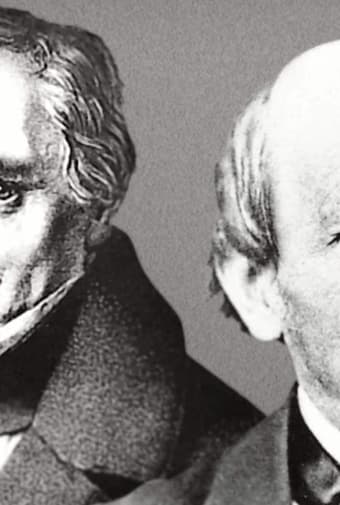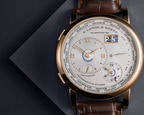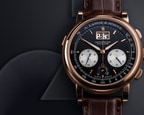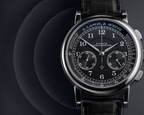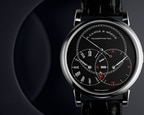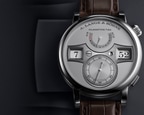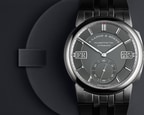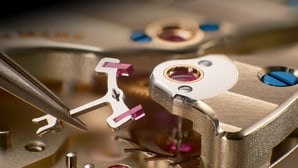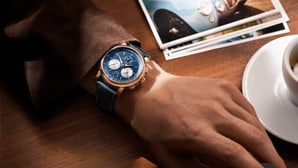Saxony succumbs to Napoleon in 1796 – and alongside him in Leipzig in 1813, in what is known as the Battle of the Nations. Three-fifths of the land and almost half the population fall victim to the war. The lifting of the Continental Blockade also puts the state under pressure. In the decade that follows, industrially manufactured English goods flood the market. The state awards loans to business people – and they use their entrepreneurial spirit to set new standards.
It is in this period, between defeat and new beginnings, that Ferdinand Adolph Lange (1815–1875) is born. Following his parents’ separation, he is raised by the family of a merchant friend. This enables him to attend the Technical School in Dresden and thus receive an education that is usually only bestowed upon engineers and technicians at the time. Alongside his schooling, Ferdinand Adolph Lange also studies with renowned master watchmaker Johann Christian Friedrich Gutkaes, who quickly recognizes and encourages his watchmaking talent.
The five-minute clock for the Semperoper opera house
When architect Gottfried Semper builds the Dresden opera house that will later bear his name, there are also plans to build a large clock for the auditorium at the king’s request. He is bothered by the fact that in other theatres, pocket watches with a chiming movement are always ringing during performances when people want to know what time it is; ultimately, the hall is dark, as it is in 2018. Johann Christian Friedrich Gutkaes receives the commission to design this clock for the audience.
To make it more readable from the more distant seats too, the plan is for the time to be shown digitally, high above the stage, using two rotating barrels. The clock turns every hour and every five minutes. Gutkaes produces the technical masterpiece in his workshop with his students – including Ferdinand Adolph Lange. Even though the Semperoper was to be destroyed and rebuilt twice since it opened, the five-minute clock still shows audiences the time.
Ferdinand Adolph Lange travels and returns
During his studies with Gutkaes, Ferdinand Adolph Lange reveals himself to have a flair for craft, a work ethic and intelligence. He completes his studies with distinction – before traveling to France, then the hub of precision watchmaking, in 1837. He works near Paris with the Austrian watchmaker Joseph Thaddeus Winnerl (1799–1886), who studied with Abraham-Louis Breguet and runs a leading watch workshop. Ferdinand Adolph Lange is the factory foreman and studies astronomy and physics at the Sorbonne in Paris at the same time – but first and foremost, he refines his skills as a watchmaker with the famous Parisian teachers.
“Don’t forget your home!”, Gutkaes writes in his apprentice’s traveling book. “It will welcome you back with open arms if you come back one day, rich in experience, and have proven yourself worthy of the art you can enrich so much.” Ferdinand Adolph Lange does return (likely in 1841) to Dresden, where Gutkaes’ daughter Antonia is waiting for him. Ferdinand and Antonia marry in 1842, which is also when he receives his master crafts-man’s diploma. In the same year, his father-in-law is appointed as the court watchmaker and is given an apartment in the palace tower.
The sketch and traveling book with all the tables, construction drawings, mechanisms and calculations show how inquisitive and meticulous Ferdinand Adolph Lange is in his ap-proach to issues of timekeeping. He builds watch parts, particularly cogs, whose speci-fications have usually been in Paris lines (1 Paris line is the equivalent of 2.2558 millimeters) until now. He converts all measurements into the much more practical metric system – still a novelty at this time.
So it comes as no surprise that Ferdinand Adolph Lange achieves huge success as a partner in his teacher and father-in-law Gutkaes’ company within a short space of time – both as a watchmaker and a businessman. His entrepreneurial ambition, as well as his social con-science and sense of civic duty, spurs him on. He begins to campaign for what is considered to be a bold plan – he wants to build his own watch manufacture in the Erzgebirge, thus creating a counterpoint to the centers of fine watchmaking in England and Switzerland.
Railways and the new perception of time
The railway, built between Dresden and Leipzig in 1839, is a huge innovation for people at this time. This form of transport changes not only the culture of travelling, but also the perception of time. What previously might have taken from “Tuesday morning” until “Wednesday evening” by carriage is now something much more precise. Yet more precise timepieces are required for timetables.
In 1835 the Adler locomotive between Nuremberg and Fürth heralds the age of the railways in Germany – despite being built in England. The first German steam locomotive is produced shortly after in Übigau, Dresden. It proudly bears the name of its home: Saxonia. Of course, the Saxonia sallies forth in 1839 when the private line to Leipzig opens. Yet the pioneering English, who have had a monopoly on railway construction thus far, prevail; two English locomotives are the first to steam along the tracks. But this doesn’t harm the success of the Saxonia, which remains in use until 1856. A fully functioning replica is in existence in 2018.
The success of the railway sees demand for precise timepieces increase. The design of many pocket watches, in turn, is based on the railway; the minute scale on the dial, the so-called timekeeping, looks like a railway track – and the hand also follows the rhythm of the waves. In 2018 the Lange model family 1815 boasts this and a few additional stylistic elements of classic pocket watches such as the three-quarter plate, blued screws and screwed gold chatons.
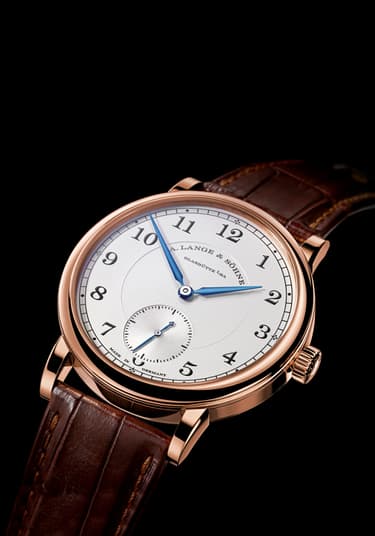
1815
Structural support
Determined and armed with the power of persuasion, watchmaker Ferdinand Adolph Lange – who has yet to celebrate his 30th birthday – begins repeatedly writing to the Saxon government in 1843. He promotes his idea: “[…]the founding of a new industry for the impoverished people of the Erzgebirge.” He works everything out thoroughly, itemizing the new business model, indicating the investment requirements and calculating the prospects for profit. In 1845 the Royal Saxon Ministry of the Interior finally agrees to this form of structural support. To hire and train 15 apprentice watchmakers in impoverished Glashütte, Ferdinand Adolph Lange receives a supplement of 5,580 thaler, repayable between 1848 and 1854 in seven installments – and an additional 1,120 thaler to buy tools.
Ferdinand Adolph Lange relocates to Glashütte. On 7 December, he welcomes his first apprentices with a festive service in his own workshop. They say all new beginnings are tough, and here is no exception – teaching young people from the region is more strenuous than previously thought and initially, watch production moves much too slowly. To get through the difficult first few years, Ferdinand Adolph Lange puts literally everything he owns into his fledgling business – and also takes on heavy debt. He never gives up hope of success – and time proves him right.
From his travels and his experiences in Gutkaes’ workshops, he knows exactly what he wants to do differently now in his own manufacture – and why. Ferdinand Adolph Lange does pioneering work in various different areas and revolutionizes fine watchmaking.
Construction precision production
Among the many improvements Ferdinand Adolph Lange works on tirelessly, the development of the distinctive three-quarter plate is particularly special – it remains one of the most important traditional elements at A. Lange & Söhne in 2018. Every pivot in the wheel work can now be fixed in a structure that is stable on all sides. Ferdinand Adolph Lange is also the first watchmaker in Europe to introduce the metric system in his workshop. Being based on the unit of the millimeter, it makes conversion easier. Working laboriously, millimeter by millimeter, he transfers the movement’s dimensions from the old Paris line measuring system to the metric system. In doing so, he is ahead of his time – the Saxon government is to officially introduce the meter in 1858.
In order to make the highest quality possible to reproduce equally, Ferdinand Adolph Lange reorganizes the manufacturing process – first and foremost by introducing the principle of division of labour. Every watchmaker specialists and is then thenceforth responsible for a certain step in the process, which reduces error rates significantly. Ferdinand Adolph Lange also improves tools, for example, with the foot-operated swivel chairs. They are used to move circular parts such as pins, pinion wheels, wheels and discs in a continuous rotating motion – making fine and precise processing possible.
"A real man honours himself"
Ferdinand Adolph Lange is more than just a watchmaking pioneer. He brings education and work, new opportunities and, ultimately, wealth back to the Erzgebirge; he takes responsibility for the greater good. From 1848 he takes up the honorary role of Mayor of Glashütte for 18 years – and helps the place flourish as a lively, well-maintained little town around the watchmaking industry he set up. He is then elected to the Saxon state parliament. Glashütte gives him the freedom of the city and sets up a Lange fund for watchmakers’ pensions.
Yet when the King of Saxony wishes to award him an honor in recognition of his service to the town, Ferdinand Adolph Lange rejects this, humbly yet decisively: “A real man honors himself!” Ferdinand Adolph Lange dies, aged 60, on 3 December 1875 – shortly before his company’s 30th anniversary.
A picture for the tsars
The only photo of Ferdinand Adolph Lange that exists is all thanks to the Russian imperial family. Such is the enthusiasm for Ferdinand Adolph Lange’s complex pocket watches with a chiming movement that it is rewarded with a valuable pin and a letter of thanks to the watchmaker, who is invited to St Petersburg. Not wishing to be away so long and neglect his work, Ferdinand Adolph Lange allows a portrait to be taken of him and the diamond pin attached to a silk scarf, and sends the photograph to the Russian imperial family. A copy is kept in Glashütte – of the only picture of Ferdinand Adolph Lange.
Explore further



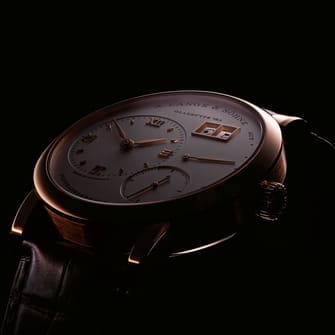
Exclusive insights into the world of fine watchmaking
Experience A. Lange & Söhne’s fascinating heritage, unique stories and exquisite timepieces by subscribing to our newsletter.
How can we be of service?
Whether you are in search of a specific model, have questions out of interest or need a service request for your timepiece – we are delighted to help you. We are at your service by phone, email or in one of our boutiques.

